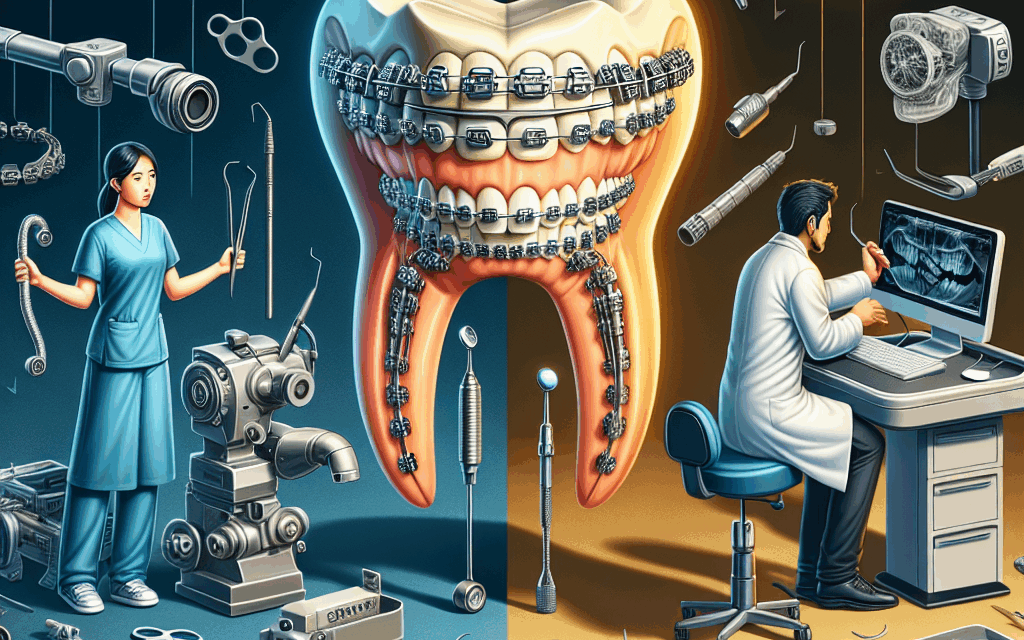Revolutionizing Orthodontics: How MedTech Innovations are Transforming Clinical Practice
Orthodontics, a specialized field of dentistry focused on diagnosing, preventing, and treating dental and facial irregularities, has undergone significant transformations in recent years. The integration of medical technology (MedTech) innovations has not only enhanced clinical practices but also improved patient outcomes and experiences. This article explores the various ways MedTech is revolutionizing orthodontics, focusing on five key areas: digital imaging and diagnostics, 3D printing, teleorthodontics, artificial intelligence, and patient engagement technologies.
1. Digital Imaging and Diagnostics
Digital imaging has become a cornerstone of modern orthodontic practice, allowing for more accurate diagnostics and treatment planning. Traditional methods of imaging, such as X-rays and plaster models, are being replaced by advanced digital technologies that provide a clearer, more comprehensive view of a patient’s dental structure.
1.1 The Shift from Traditional to Digital Imaging
In the past, orthodontists relied heavily on two-dimensional X-rays and physical impressions to assess a patient’s dental condition. These methods, while effective, had limitations in terms of accuracy and patient comfort. The advent of digital imaging technologies, such as cone beam computed tomography (CBCT) and intraoral scanners, has transformed this landscape.
- CBCT: This technology provides three-dimensional images of the teeth, jaws, and surrounding structures, allowing orthodontists to visualize complex anatomical relationships. Studies have shown that CBCT can improve diagnostic accuracy by up to 30% compared to traditional X-rays.
- Intraoral Scanners: These devices capture detailed digital impressions of a patient’s mouth without the discomfort associated with traditional impression materials. They enhance patient experience and reduce the time spent in the chair.
1.2 Enhanced Treatment Planning
The integration of digital imaging into orthodontic practice has significantly improved treatment planning. With high-resolution images, orthodontists can create more precise treatment plans tailored to individual patient needs. This level of customization is crucial for achieving optimal results.
Moreover, digital imaging allows for the simulation of treatment outcomes. Orthodontists can use software to model the expected changes in a patient’s dental structure over time, providing both the clinician and the patient with a clear understanding of the treatment process.
1.3 Case Study: The Impact of Digital Imaging
A study conducted at a leading orthodontic clinic demonstrated the effectiveness of digital imaging in improving treatment outcomes. The clinic transitioned from traditional imaging methods to digital technologies, resulting in a 25% reduction in treatment time and a 15% increase in patient satisfaction scores. Patients reported feeling more informed and engaged in their treatment process, highlighting the importance of clear communication facilitated by digital tools.
2. 3D Printing in Orthodontics
3D printing technology has emerged as a game-changer in orthodontics, enabling the rapid production of custom appliances and aligners. This innovation not only streamlines the manufacturing process but also enhances the precision and effectiveness of orthodontic treatments.
2.1 Customization and Efficiency
One of the most significant advantages of 3D printing is the ability to create highly customized orthodontic devices. Traditional methods of appliance fabrication often involved labor-intensive processes that could take days or even weeks. In contrast, 3D printing allows for the on-demand production of aligners, retainers, and other appliances in a matter of hours.
- Aligners: Companies like Align Technology have pioneered the use of 3D printing for clear aligners, allowing for precise adjustments based on a patient’s unique dental anatomy.
- Retainers: 3D printing enables the production of custom retainers that fit perfectly, reducing the likelihood of discomfort and improving patient compliance.
2.2 Cost-Effectiveness and Accessibility
The cost-effectiveness of 3D printing is another significant benefit. By reducing the time and labor involved in appliance fabrication, orthodontic practices can lower their operational costs. This reduction in costs can be passed on to patients, making orthodontic treatment more accessible to a broader population.
Furthermore, 3D printing technology can be implemented in various practice settings, from large clinics to small private practices. This democratization of technology ensures that more patients can benefit from advanced orthodontic care.
2.3 Case Study: 3D Printing in Action
A prominent orthodontic practice in California adopted 3D printing technology to enhance its service offerings. By integrating a 3D printer into their workflow, the practice reduced appliance production time by 70%. As a result, they were able to increase their patient volume and improve overall satisfaction rates. Patients appreciated the quick turnaround for their aligners and the personalized approach to their treatment.
3. Teleorthodontics: The Future of Remote Care
Teleorthodontics is an emerging field that leverages technology to provide remote orthodontic care. This innovation has gained traction, especially in the wake of the COVID-19 pandemic, as patients and providers sought safer alternatives to in-person visits.
3.1 The Rise of Remote Consultations
Teleorthodontics allows patients to consult with their orthodontists remotely, using video conferencing tools and mobile applications. This approach has several advantages:
- Convenience: Patients can schedule consultations from the comfort of their homes, eliminating the need for travel and reducing time away from work or school.
- Accessibility: Teleorthodontics can reach patients in remote or underserved areas who may not have easy access to orthodontic care.
3.2 Monitoring Progress Remotely
In addition to consultations, teleorthodontics enables orthodontists to monitor treatment progress remotely. Patients can send photos or use mobile apps to track their progress, allowing for timely adjustments to treatment plans without the need for frequent office visits.
This remote monitoring capability not only enhances patient engagement but also allows orthodontists to identify potential issues early, reducing the risk of complications and ensuring smoother treatment outcomes.
3.3 Case Study: Teleorthodontics in Practice
A teleorthodontics platform launched during the pandemic reported a 50% increase in patient engagement compared to traditional in-office visits. Patients appreciated the flexibility of remote consultations and the ability to receive timely feedback on their treatment progress. This case highlights the potential of teleorthodontics to enhance patient satisfaction and improve treatment adherence.
4. Artificial Intelligence in Orthodontics
Artificial intelligence (AI) is making significant inroads into orthodontics, offering tools that enhance diagnostics, treatment planning, and patient management. AI algorithms can analyze vast amounts of data to identify patterns and predict treatment outcomes, leading to more informed decision-making.
4.1 AI-Driven Diagnostics
AI technologies can assist orthodontists in diagnosing dental issues more accurately. Machine learning algorithms can analyze digital images and X-rays to detect anomalies that may be missed by the human eye. This capability enhances diagnostic precision and reduces the risk of misdiagnosis.
- Predictive Analytics: AI can analyze historical patient data to predict treatment outcomes, helping orthodontists make more informed decisions about treatment plans.
- Automated Treatment Planning: AI can streamline the treatment planning process by generating recommendations based on a patient’s unique dental anatomy and treatment goals.
4.2 Enhancing Patient Communication
AI-powered chatbots and virtual assistants are also being integrated into orthodontic practices to improve patient communication. These tools can answer common questions, schedule appointments, and provide reminders, freeing up staff to focus on more complex tasks.
By enhancing communication, AI tools can improve patient satisfaction and engagement, leading to better treatment adherence and outcomes.
4.3 Case Study: AI in Action
A leading orthodontic practice implemented an AI-driven diagnostic tool that reduced the time spent on initial assessments by 40%. The tool analyzed patient data and provided orthodontists with detailed reports, allowing for quicker and more accurate treatment planning. This efficiency not only improved patient flow but also enhanced overall practice productivity.
5. Patient Engagement Technologies
Patient engagement is a critical aspect of successful orthodontic treatment. MedTech innovations are providing new ways to engage patients throughout their treatment journey, fostering better communication and adherence to treatment plans.
5.1 Mobile Applications for Patient Engagement
Mobile applications designed for orthodontic patients are becoming increasingly popular. These apps offer a range of features that enhance patient engagement:
- Appointment Reminders: Patients can receive notifications about upcoming appointments, reducing the likelihood of missed visits.
- Progress Tracking: Many apps allow patients to track their treatment progress, providing visual representations of their journey.
5.2 Gamification of Treatment
Some orthodontic practices are incorporating gamification elements into their patient engagement strategies. By turning treatment milestones into games or challenges, practices can motivate patients to adhere to their treatment plans. For example, patients might earn rewards for wearing their aligners consistently or attending regular check-ups.
This approach not only makes the treatment process more enjoyable but also fosters a sense of ownership and responsibility among patients.
5.3 Case Study: Successful Patient Engagement
A dental practice that implemented a mobile app for patient engagement reported a 30% increase in appointment adherence and a significant improvement in patient satisfaction scores. Patients appreciated the convenience of tracking their progress and receiving reminders, leading to a more positive treatment experience.
Conclusion
The integration of MedTech innovations in orthodontics is revolutionizing clinical practice, enhancing diagnostic accuracy, treatment efficiency, and patient engagement. From digital imaging and 3D printing to teleorthodontics and AI, these advancements are transforming the way orthodontic care is delivered.
As the field continues to evolve, orthodontists who embrace these technologies will be better equipped to meet the needs of their patients, ultimately leading to improved outcomes and satisfaction. The future of orthodontics is bright, and the ongoing innovations in MedTech promise to further enhance the quality of care provided to patients around the world.
In summary, the key takeaways from this exploration of MedTech innovations in orthodontics include:
- The shift from traditional imaging to digital technologies enhances diagnostic accuracy and treatment planning.
- 3D printing streamlines the production of custom appliances, improving efficiency and accessibility.
- Teleorthodontics offers remote care options that enhance patient convenience and engagement.
- AI technologies improve diagnostics and treatment planning, leading to better patient outcomes.
- Patient engagement technologies foster communication and adherence, enhancing the overall treatment experience.
As we look to the future, it is clear that MedTech innovations will continue to play a pivotal role in shaping the landscape of orthodontics, ultimately benefiting both practitioners and patients alike.





